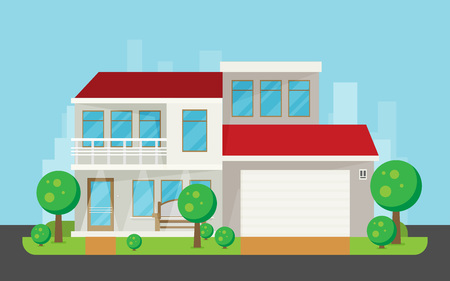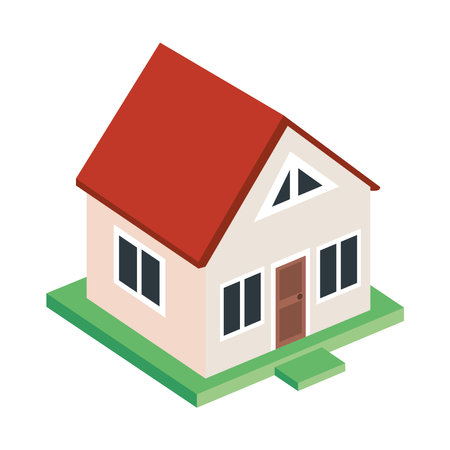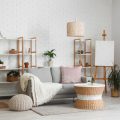Smart Storage Solutions for Tight Spaces
Living in a small apartment or house doesn’t mean you have to sacrifice comfort or style. With some clever DIY storage solutions, you can make the most of every square foot and keep your home organized. Let’s dive into practical projects that save space and boost function, all while adding a personal touch to your place.
Under-Bed Storage: Hidden Goldmine
The space under your bed is often overlooked, but it’s perfect for stashing things out of sight. Try these DIY ideas:
| DIY Project | What You Need | Benefits |
|---|---|---|
| Rolling Under-Bed Drawers | Old drawers or wooden crates, casters, paint | Keeps shoes, linens, or seasonal clothes organized and easy to reach |
| Fabric Zipper Bags | Heavy-duty fabric, zipper, sewing kit | Dust-proof solution for delicate items like sweaters or bedding |
| Slim Plastic Bins with Labels | Clear bins, label maker or stickers | Makes finding stored items quick and hassle-free |
Hang It Up: Vertical Space Hacks
If floor space is tight, look up! Use your walls and doors to add extra storage without cluttering your home:
- Over-the-Door Organizers: Perfect for shoes, cleaning supplies, snacks, or even craft materials. They’re super easy to hang and move around.
- Pegboards: Mount a pegboard in the kitchen, entryway, or bathroom for instant hooks and shelves—great for keys, utensils, jewelry, or bags.
- Wall-Mounted Racks: Install racks or rails for hanging pots and pans in the kitchen or towels in the bathroom.
Multipurpose Shelving Units: Do More With Less
Shelving isn’t just for books! Build custom shelves that pull double duty—think shoe storage with a bench on top by the entryway, floating shelves above the desk for both decor and files, or cube organizers that work as room dividers in a studio apartment.
| Shelving Idea | Main Materials | Where To Use It |
|---|---|---|
| Cubby Bench Combo | Plywood, foam cushion, paint or stain | Entryway or mudroom for shoes and backpacks |
| Floating Corner Shelves | Wood planks, brackets | Bathroom corners for toiletries and towels |
| Ladder Shelf Unit | Ladder (old or new), wood boards | Bedroom or living room for books and plants |
Your Small Space Potential Awaits!
Tackling these easy DIY storage projects will help transform even the tiniest apartments into organized and stylish retreats. With a little creativity—and maybe a Saturday afternoon—you can unlock hidden storage spots all over your home.
Functional Furniture Upgrades
How to Maximize Every Inch with Smart DIY Furniture
If you’re working with a small space, every piece of furniture needs to earn its keep. Instead of settling for traditional bulky items, consider upgrading to convertible and multifunctional pieces that can totally transform your living area. Not only do these upgrades make life easier, but they can also boost your home’s value and appeal if you ever decide to rent or sell.
Top Convertible Furniture Ideas for Small Spaces
| DIY Project | Main Benefit | What Youll Need |
|---|---|---|
| Murphy Bed (Wall Bed) | Transforms your bedroom into a living or work space during the day | Plywood, wall mount kit, mattress, drill, paint/stain |
| Fold-Down Desk | Creates an instant office without taking up floor space | Hinges, sturdy board or desk top, wall anchors, brackets |
| Nesting Tables | Flexible surfaces for work, dining, or entertaining—store away when not needed | Lumber or pre-cut tabletops, table legs, screws, finish of choice |
| Sofa with Storage Drawers | Adds hidden storage while doubling as seating or guest bed | Wood panels, drawer slides, foam cushion, upholstery fabric |
| Convertible Coffee Table (Lift-Top or Expandable) | Doubles as a dining table or workspace in seconds | Lift-top hardware kit, tabletop slab, base structure materials |
Step-by-Step: DIY Fold-Down Desk Example
- Measure Your Space: Pick a wall spot that gets good light and has room for a chair when the desk is down.
- Select Materials: Use a sturdy board for the desktop—about 1-1.5 inches thick works well. Grab strong hinges and wall anchors.
- Install Wall Brackets: Mark the stud locations and secure your brackets at desk height (typically 28-30 inches from the floor).
- Attach Desktop: Fasten one side of the board to the wall using hinges so it folds down flat against the wall when not in use.
- Add Support: Install folding support legs or a slide-out bracket underneath for stability when open.
- Finish It Off: Paint or stain to match your decor. Add hooks above for supplies if desired.
Why Functional Furniture Pays Off in Small Spaces
- Saves Money: One convertible piece does the job of two or three regular ones—no need to buy extra furniture.
- Adds Resale/Rental Value: Smart upgrades attract buyers and renters looking for efficient city living.
- Makes Life Easier: Switch up your space on demand—work from home by day, entertain by night!
- Personal Satisfaction: There’s nothing like enjoying a custom-made solution that fits your exact lifestyle and taste.
Your Next Move: Start Small!
You don’t have to be a woodworking pro to get started. Try building a simple nesting table set or installing a fold-down desk first. As you gain confidence—and see how much more livable your space becomes—you’ll want to tackle even bigger projects!

3. Creative Room Dividers for Open Concepts
Living in a studio apartment or an open-concept space can feel challenging when you crave a little privacy. Luckily, you don’t have to spend a fortune on renovations. With some DIY magic, you can easily create private zones that fit your style and budget. Here are some budget-friendly ways to divide your space without sacrificing square footage:
Portable Screens: Instant Separation
Folding screens are a classic option for dividing rooms, and the best part—they’re portable! You can buy basic panels at stores like IKEA or Target, or build your own with lightweight wood frames and fabric. Paint them to match your decor or use bold patterns for a statement piece. When you need more space, just fold them up and tuck them away.
Bookshelves as Functional Dividers
If you want to add both storage and separation, bookshelves are the way to go. Position an open bookshelf between your living area and bedroom to define each zone while keeping things airy and accessible. Choose a unit that’s tall enough for privacy but not so bulky that it blocks light. For a personal touch, fill the shelves with books, plants, baskets, or decorative items.
DIY Curtains for Flexible Privacy
Curtains aren’t just for windows—they make fantastic room dividers too! Install a ceiling-mounted curtain rod or tension wire across your desired area. Hang floor-length curtains to create instant walls you can open or close as needed. Go for sheer fabrics if you want light to flow through, or choose blackout curtains for maximum privacy.
Room Divider Comparison Table
| Option | Cost | DIY Difficulty | Extra Benefits |
|---|---|---|---|
| Portable Screens | $40-$100 | Easy | Moveable; customizable designs |
| Bookshelves | $50-$200 | Medium | Adds storage; doubles as decor |
| DIY Curtains | $20-$80 | Easy | Flexible; softens the room look |
No matter which divider you choose, these ideas will help turn one big room into several cozy spaces—without breaking the bank!
4. Wall-Mounted Space Savers
If you’re living in a small space, every inch counts. That’s where wall-mounted solutions come in—they’re game changers for freeing up your floors and staying organized, all without breaking the bank. Let’s dive into some DIY ideas that are both trendy and practical.
Floating Shelves: Style Meets Storage
Floating shelves are a sleek way to add storage without making your room feel cramped. You can install them above your desk, couch, or bed to display books, photos, plants, or even kitchen essentials. Plus, you only need a drill and some basic hardware to get started. Opt for wood finishes or modern metals to match your vibe.
Wall Hooks: Instant Organization
Wall hooks aren’t just for coats! Use them by the front door for bags and hats, in the bathroom for towels, or in your bedroom for jewelry and accessories. Mix and match different styles—think rustic wood pegs or colorful metal—for a look that’s totally you.
Pegboards: Customizable & Affordable
Pegboards are a small-space superstar because you can rearrange them anytime your needs change. Mount one above your workspace for craft supplies, in the kitchen for utensils, or in the entryway for keys and mail. Paint them to add a pop of color or stick with classic white for a clean look.
| DIY Project | Best For | Estimated Cost | Skill Level |
|---|---|---|---|
| Floating Shelves | Living room, kitchen, bedroom | $20–$50 per shelf | Beginner–Intermediate |
| Wall Hooks | Entryway, bathroom, closet | $10–$30 per set | Beginner |
| Pegboard Organizer | Home office, craft area, garage | $15–$40 per board | Beginner–Intermediate |
The bottom line? Getting stuff up on the walls is one of the smartest moves you can make if you want to maximize your small space—plus it keeps everything within easy reach and totally on trend.
5. Multi-Use Entryways and Mudrooms
Make the Most Out of Every Inch
When you’re living in a small space, even your entryway can work double duty. You don’t need a grand foyer to create a functional drop zone that keeps clutter out of your main living area. Here’s how you can turn even the tiniest entry into an organized, multi-use spot with some smart DIY upgrades.
DIY Ideas for Your Entryway
| Project | What You Need | Benefits |
|---|---|---|
| Wall-Mounted Coat Rack | Wood board, hooks, drill, screws, paint/stain | Keeps jackets and bags off the floor; adds style |
| Shoe Storage Bench | Small bench or cube shelves, baskets or bins | Organizes shoes; offers seating for putting them on |
| Key Organizer Shelf | Mini shelf, hooks, labels (optional) | No more lost keys; extra spot for sunglasses or mail |
| Vertical Cubbies or Baskets | Narrow shelving unit or wall-mounted baskets | Stores hats, gloves, scarves in winter; dog leashes year-round |
Quick Tips for Small Entryways
- Go vertical: Use your wall space from floor to ceiling for racks and shelves.
- Add mirrors: A mirror makes your entry look bigger and lets you check your look before heading out.
- Create a drop zone: Designate one spot for daily essentials—wallets, mail, and keys—to keep things tidy.
- Choose slim furniture: Opt for narrow benches or floating shelves to save floor space.
- Label everything: Use labels or color-coded baskets so everyone knows where things go—especially helpful for families.
The Investment Angle: Why It Pays Off
A well-organized entryway isn’t just about looks—it saves you time every morning and keeps your home less chaotic. Plus, these simple DIY projects are affordable and add value if you ever decide to rent or sell your place. In American homes where first impressions count, upgrading your mudroom or entryway is a smart investment with quick returns in daily convenience and long-term property appeal.
6. Brightening Small Spaces with Lighting Hacks
Good lighting can make any small space feel bigger, brighter, and more inviting. With a few simple and budget-friendly DIY projects, you can give your rooms a whole new vibe—no electrician required! Here are some easy lighting hacks that pack a serious punch for small-space living.
Easy DIY Lighting Projects
| Project | What You Need | Estimated Cost | Why It Works |
|---|---|---|---|
| LED Strip Lights Under Shelves | Peel-and-stick LED strips, power adapter | $15-$30 | Adds ambient light and makes shelves look like they float |
| Plug-in Wall Sconces Upgrade | New plug-in sconces, wall anchors, screws | $25-$60 per pair | Lifts lighting off tables, saves surface space, looks modern |
| Mirror + Fairy Lights Combo | Full-length mirror, string lights or fairy lights, adhesive hooks | $20-$40 | Doubles the light in the room and adds a cozy glow |
| Cordless Rechargeable Lamps | Battery-operated lamps or lanterns | $15-$50 each | No outlets needed—move them wherever you need extra light! |
| Smart Bulbs with Adjustable Color Temp | WiFi-enabled smart bulbs (compatible with Alexa/Google) | $10-$20 each | Easily switch from warm to cool light to set the mood or open up the room visually |
Pro Tips for Maximizing Light in Small Rooms
- Aim lights at walls or ceilings: This bounces light around and creates the illusion of more space.
- Use multiple light sources: Layer overhead lights, lamps, and accent lights for depth.
- Avoid heavy lampshades: Go for clear or light-colored shades to keep things bright.
- Stick to LEDs: They’re energy-efficient and don’t add heat to tight spaces.
- Add mirrors: Placing mirrors across from windows or lamps doubles the effect.
Try This Quick Win: LED Under-Cabinet Lighting Hack
If your kitchen or desk area feels dark and cramped, install peel-and-stick LED strips underneath cabinets or shelves. Just measure, stick on, plug in, and watch your workspace instantly brighten up. No drilling, no rewiring—just pure DIY satisfaction!

